
|
The Bronze Age

1972-1986
"An age where men and women wore their greatness as easily as they wore their clothing or their names..."
- Elliot S! Maggin, (DC Comics Presents Annual #4)
Control over the Man of Steel was initially parceled out to a group of
editors but it was all consolidated under Julius Schwartz, a man whose
credentials were at least as impeccable as Weisinger's. His career
extended back into the first decade of comics and before that, into
the first generation of science fiction fandom (Superman #411).
He had presided over
the revitalization of virtually all of DC's most established
characters. It seemed logical that he would cap his career with a
complete revamping of the greatest of them all, Superman.
He left the strip shortly thereafter and Superman's
powers immediately increased again. Two thirds of infinite power is,
after all, still a pretty hefty weapon to wield.
Other aspects of Schwartz's initial plan to revamp Superman were
longer lasting. Whereas Mort had created a coherent Superman
continuity, he had for the most part avoided the need for continuity
with the other DC editors' titles. Julie put an end to this. First,
in World's Finest and then in DC Presents, Superman was
confronted with an endless stream of DC characters. Eventually the
question would have to be answered. How did the Man of Steel fit into
the DC universe? What was his relationship to the Guardians, for
example? Who was faster, Superman or the Flash?
The answers came in bits and pieces, pieces which have never been assembled
into a whole within a single story, but which clearly indicate that
Superman served a bigger purpose in the DC universe than he had in the
Superman one.
It started in January 1972, with new writer
Elliot Maggin's
"Must There Be a Superman?"
(Superman #247). For the first time,
Superman started to become aware of larger issues - like just what effect his
presence on Earth was having on the development of human society.
Previous writers had criticized Superman as being
"too powerful," but Maggin
and fellow writer Cary Bates, who had been
on Superman since 1967, took the approach that Superman, by
definition, was supposed to be powerful. They began to
explore Superman's legend and focus on his moral righteousness,
subtly constructing a new continuity built upon his
Silver Age
history and succesfully transforming him into a much
more inspiring figure than he had ever been before.
As the decade progressed, it was no longer sufficient for him to be merely
Earth's mightiest mortal, he became the universe's:
Meanwhile, on a planet in the exact center of the Milky Way Galaxy, a
race that is almost as old as the universe takes it upon itself to
guard the growth of intelligent life on as many planets as possible,
first through a corps of robots assigned to protect a small group of
planets (the robots would later become known as Manhunters), later
with a galaxy spanning batallion of magic ring wielding warriors.
Realizing that even immortals can't last forever, the self-styled
"Guardians of the Universe" hope someday to turn their task over
completely to these Green Lanterns, if only a warrior of such noble
proportions can be found who would be capable of leading them
[Superman #257].
In a seemingly unrelated event, a race of gaseous beings called the
"Sun Thrivers" created a giant red sun by drawing matter from nearby
parts of the galaxy. They intended to use this star as a home for
themselves as they travelled around the universe. The fate of their
original star is unknown. Presumably it was destroyed in some manner,
possibly a manner similar to the ultimate fate of this new sun.
Indeed, this sun proved to be an unstable vehicle. The Sun Thrivers
compensated for this unbalance by creating planets to orbit their sun.
One of these planets, made of incredibly dense matter, was unstable
itself. However, the Sun Thrivers managed to hold it together for
10,000 years, long enough for another race of cosmic beings to get
some use out of it [Superman #255].
Soon after the creation of this incredible artifact, two space
explorers crash landed separately on its surface. Even though they
didn't know of each other's existence, they managed to find each other
on its gigantic continents. Unable to rebuild their crafts, the two
astronauts are forced to make the best of life on the barren planet,
with its wispy atmosphere of crimson gases. Coincidentally, the two
astronauts turned out to be a male and female of the same species, one
named Kryp, the other, Tonn [Superman #238].
These two stranded astronauts turned a world so unfit for life that
early generations had to sleep more than half the day and felt more
comfortable crawling than walking, into a bustling super scientific
civilized world. The weakest died before they could produce children,
but the human species displayed its surprising adaptability and
evolved to meet the challenge.
The race's physiology was subtly altered, although the outward
appearance changed very little. Muscle tissue became denser. Motor
reflexes became sharper. Optic capacities widened. The race began
expanding out from the low gravity regions around the equator to the
upper latitudes. At least, that's the way
Elliot Maggin
described it
in his 1978 novel
Superman: Last Son of Krypton.
Central to the history of this evolving planet was an
incredible
family called "El." Kings, philosophers, scientists, explorers,
musicians, and architects all followed one another with bewildering
rapidity. It was almost as if someone was watching this family,
guiding them, in order to produce an evolutionary masterpiece, a
Superman [The Krypton Chronicles].
Unfortunately, the planet they had chosen for this experiment was
unstable and due to self destruct. A Green Lantern named
Tomar-Re was
dispatched to preserve the planet until Jor-El could build a space ark
and escape to found a new colony. This plan, too, came to disaster,
as the space villain, Brainiac, stole Jor-El's completed space ark
when he shrunk the city of
Kandor and placed it in a bottle. Though
he fought valiantly, Tomar-Re was only mortal. He could not save
Krypton, and so all perished, except for Kal-El, who was rocketed
desperately away into space by his father, determined that at least
something from Krypton would live on
(see [Superman #257]).
Soon, the Kents realized that this child had spectacular abilities.
Clark, for instance, learned to read English almost immediately,
although he exhibited a contempt for the rules of grammar, saying
things like, "Me want finish reading Tale of Two Cities !"
(
Last Son of Krypton 11).
The space ship Kal-El had flown in had opened up a space warp,
dragging all manner of debris from the vicinity of Krypton, including,
in addition to a large swarm of
kryptonite, a lost satellite
containing his pet dog,
Krypto.
The presence of this cosmic being, and perhaps the matter he had
dragged along with him, seemed to upset something in the equilibrium
of the planet. It was almost as if a mystical magnetic force had been
shot through the atmosphere. Extraordinary beings of all shapes and
sizes began to appear, where for all of the planet's past history,
there had been none whatsoever. Men of cosmic powers were attracted
to this globe as if it were a focal point, a cosmic crisis point,
waiting for something of universal import to take place (JLA
#153)
That event was a dream that came to Jonathan Kent, causing him to
awaken in the middle of the night and draw a strange symbol, a weird
design, "something like a test pattern" as Perry White called it in
Superman #417. Somehow, Jonathan Kent knew that his foster son
was destined to wear this symbol and bring it to the far corners of
the universe [Superman Annual #10].
First as Superboy, then as Superman, he fought as a champion of
justice, the first in a seemingly endless series of super beings that
came to inhabit the planet Earth. It was almost as if super powers
were contagious, as if he had so much super energy that he radiated it
to others.
It came to pass that, in the course of a great battle for Truth and
Justice, man and sword finally came together. For the first time the
sword allowed itself to be grasped by the hand of a man. Holding it,
Superman found himself expanding, spreading across the winds of the
universe, the whole history of creation flooding his mind. His
consciousness expanded, he was becoming an all-seeing, all knowing
Protector. Then he let it go.
"You have done well, my son. You have earned your name. Your future
is yours to make. Your greatness among living things is assured."
This message was left in his head as the sword receded into the
blackness of space once again. The sword remains out there. It waits
until he who has earned it is ready to retrieve it and fulfill his
ultimate destiny in Eternity (Superman Annual #10).
Jerry Siegel
left DC Comics again in the mid-1960s. Hamilton and
Binder also retired before the decade was over. The end of an era
finally came in 1970, when
Mort Weisinger, the man who had presided
over more of Superman's adventures than anyone before or since,
retired.
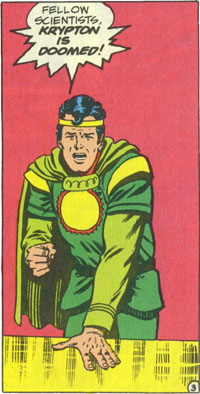
In Superman #233 (Jan. 1971) new scripter Denny O'Neil began an
eight-part adventure designed to change forever the life of Superman.
(See The Sandman Saga.)
By the end of it, Superman's powers had been reduced by one third.
O'Neil's reasoning behind this was that Superman had simply grown too
powerful to be an interesting character anymore.
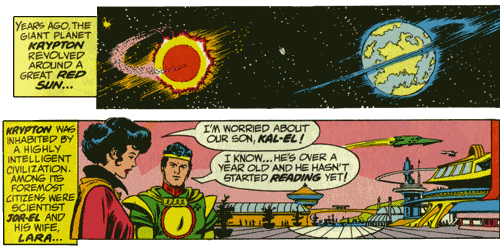
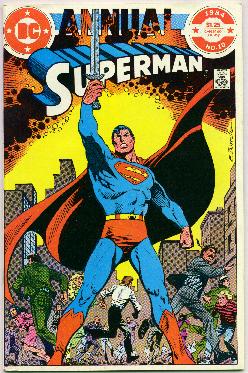
That someone, most likely, was the aforementioned Guardians of the
Universe. For 10,000 years they had manipulated the descendants of
Kryp and Tonn until, in
Jor-El and
Lara, they had created the
genetically perfect couple, the couple who would produce the one who
would be heir to the Guardians, who would rule the Green Lantern Corps
after their passing, Kal-El, the greatest Green Lantern of them all!
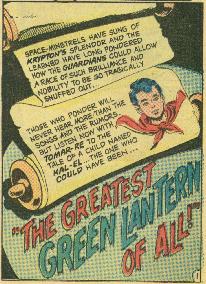
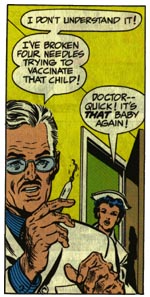 The rocket bearing Krypton's last son landed in Smallville, Maryland
(or was it Kansas?) where, with the intercession of the famous
scientist, Albert Einstein, who had been contacted by Jor-El for help,
the foundling was adopted by the Kents. (This moving the time of
Superboy's adventures from the 1930s to the 1960s.)
The rocket bearing Krypton's last son landed in Smallville, Maryland
(or was it Kansas?) where, with the intercession of the famous
scientist, Albert Einstein, who had been contacted by Jor-El for help,
the foundling was adopted by the Kents. (This moving the time of
Superboy's adventures from the 1930s to the 1960s.)
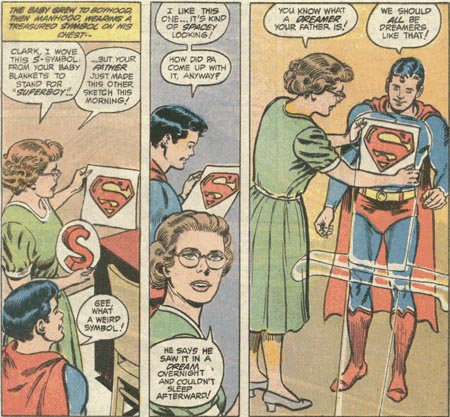

| Now On-Sale!Superman in the Seventiesabout the book |
|
. . . . . . . . . . . . . . . . . . . . . . . . . . . . . . . . . . |